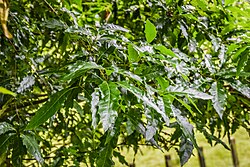Biology:Quercus canbyi
| Quercus canbyi | |
|---|---|

| |
| Quercus canbyi x Q. xalapensis hybrid in Hackfalls Arboretum | |
| Scientific classification | |
| Kingdom: | Plantae |
| Clade: | Tracheophytes |
| Clade: | Angiosperms |
| Clade: | Eudicots |
| Clade: | Rosids |
| Order: | Fagales |
| Family: | Fagaceae |
| Genus: | Quercus |
| Subgenus: | Quercus subg. Quercus |
| Section: | Quercus sect. Lobatae |
| Species: | Q. canbyi
|
| Binomial name | |
| Quercus canbyi Trel.
| |
| Synonyms[2] | |
| |
Quercus canbyi (Canby oak, Sierra oak), synonyms including Quercus graciliformis, is a North American species of oak tree.[2]
Description
Quercus canbyi is a semi-evergreen - evergreen tree,[3] up to 40–50 feet (12–15 metres) tall in cultivation. Although, it can reach up to 80 feet (24 metres) in the wild in Mexico. It starts as a pyramidal form and then matures into an open irregular shape.[4] It can reach a spread of 30–40 feet (9.1–12.2 metres) wide.[5]
The dark, glossy green leaves are 6–8 inches (15–20 centimetres) long and have serrated edges. The petioles can have a reddish hue.[6] It blooms in March and the acorns are then seen in August.[7][8]
It has been distinguished from Quercus graciliformis by its twig shape and by producing acorns biennially rather than annually;[9] however (As of February 2023), Plants of the World Online regards them as synonymous.[2]
Taxonomy
Quercus canbyi was first described by William Trelease in 1924.[2] It is placed in Quercus section Lobatae.[10]
Distribution
The species has been found only in Texas and in northeast Mexico.[2][11]
Conservation
Quercus canbyi was assessed in 2016 for the IUCN Red List as "least concern".[1] Quercus graciliformis, regarded as a synonym by Plants of the World Online, was assessed as "critically endangered" in 2016.[12]
Cultivation
Quercus canbyi will tolerate most kinds of soils and is used in gardens to provide shade.[13]
References
- ↑ 1.0 1.1 Jerome, D.; Beckman, E. (2018). "Quercus canbyi". IUCN Red List of Threatened Species 2018: e.T78809316A78809335. doi:10.2305/IUCN.UK.2018-2.RLTS.T78809316A78809335.en. https://www.iucnredlist.org/species/78809316/78809335. Retrieved 17 August 2022.
- ↑ 2.0 2.1 2.2 2.3 2.4 "Quercus canbyi Trel. | Plants of the World Online | Kew Science" (in en). https://powo.science.kew.org/taxon/urn:lsid:ipni.org:names:215619-2.
- ↑ Harrison L. Flint Landscape Plants for Eastern North America: Exclusive of Florida and the Immediate Gulf Coast (1997), p. 533, at Google Books
- ↑ "Quercus canbyi (Chisos Oak, Graceful Oak, Oaks, Sierra Oak, Slender Oak) | North Carolina Extension Gardener Plant Toolbox". https://plants.ces.ncsu.edu/plants/quercus-canbyi/.
- ↑ Howard Garrett Plants for Houston and the Gulf Coast (2010), p. 59, at Google Books
- ↑ "Quercus canbyi (Canby Oak, Sierra Oak)". https://mswn.com/plants/quercus-canbyi-canby-oak/.
- ↑ "Quercus canbyi - Trees and Shrubs Online". https://treesandshrubsonline.org/articles/quercus/quercus-canbyi/.
- ↑ A. Michael Powell Grasses of the Trans-Pecos and Adjacent Areas (1994), p. 94, at Google Books
- ↑ Jackie M. Poole, William R. Carr and Dana M. Price Rare Plants of Texas: A Field Guide (2007), p. 421, at Google Books
- ↑ Denk, Thomas; Grimm, Guido W.; Manos, Paul S.; Deng, Min; Hipp, Andrew L. (2017) (xls). Appendix 2.1: An updated infrageneric classification of the oaks. doi:10.6084/m9.figshare.5547622.v1. https://figshare.com/articles/dataset/Appendix_2_1_________An_updated_infrageneric_classification_of_the_oaks/5547622/1. Retrieved 24 February 2023.
- ↑ "SelecTree: A Tree Selection Guide". https://selectree.calpoly.edu/tree-detail/1606.
- ↑ Beckman, E. (2017). "Quercus graciliformis". IUCN Red List of Threatened Species 2017: e.T30954A63729730. doi:10.2305/IUCN.UK.2017-2.RLTS.T30954A63729730.en. https://www.iucnredlist.org/species/30954/63729730. Retrieved 16 November 2021.
- ↑ Howard Garrett Texas Gardening the Natural Way: The Complete Handbook (2010), p. 377, at Google Books
Wikidata ☰ {{{from}}} entry
 |


